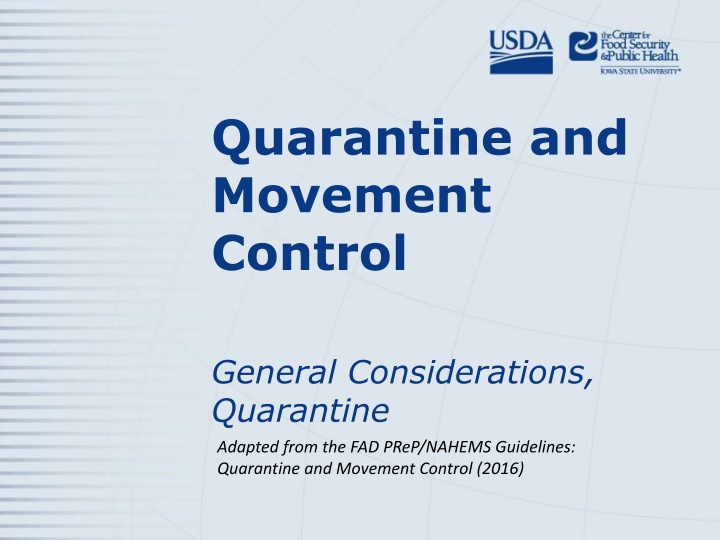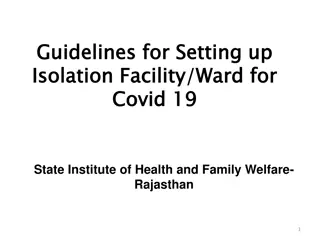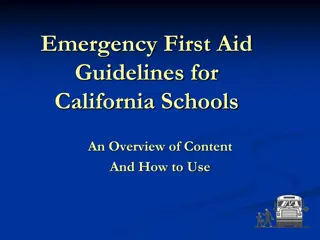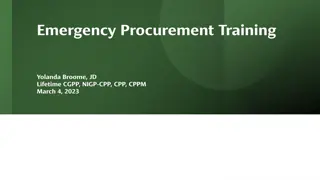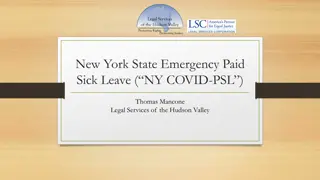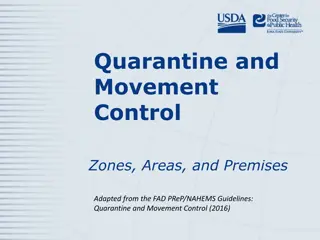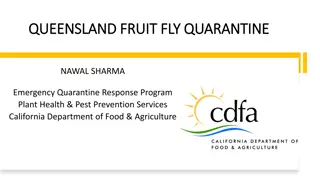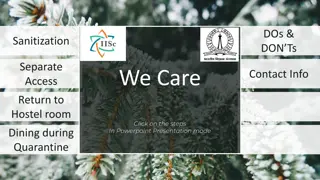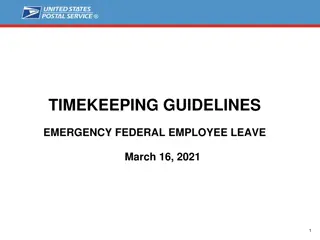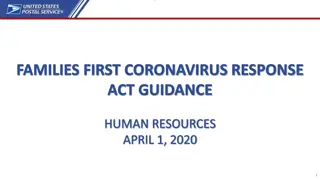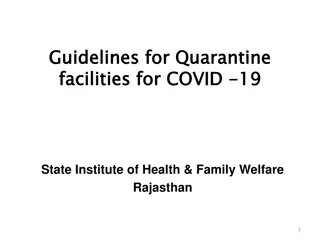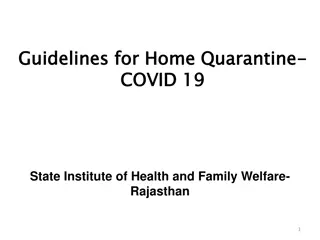Guidelines for Quarantine and Movement Control in Emergency Situations
The guidelines provide comprehensive considerations for implementing quarantine measures to prevent disease spread, ensure coordination among various agencies, and facilitate cooperation in emergency management. Key aspects include planning, coordination with local, state, and federal authorities, development of communication plans, and identification of resources for effective response. The focus is on controlling, containing, and eradicating diseases through strategic management strategies outlined in the guidelines.
Download Presentation

Please find below an Image/Link to download the presentation.
The content on the website is provided AS IS for your information and personal use only. It may not be sold, licensed, or shared on other websites without obtaining consent from the author.If you encounter any issues during the download, it is possible that the publisher has removed the file from their server.
You are allowed to download the files provided on this website for personal or commercial use, subject to the condition that they are used lawfully. All files are the property of their respective owners.
The content on the website is provided AS IS for your information and personal use only. It may not be sold, licensed, or shared on other websites without obtaining consent from the author.
E N D
Presentation Transcript
Quarantine and Movement Control General Considerations, Quarantine Adapted from the FAD PReP/NAHEMS Guidelines: Quarantine and Movement Control (2016)
This Presentation Quarantines - premises and area Coordination and planning Resolving competing priorities Prevent disease spread Continue key operations Implementing and releasing quarantine FAD PReP/NAHEMS Guidelines: Quarantine & Movement Control - Considerations 2 USDA APHIS and CFSPH
General Considerations FAD PReP/NAHEMS Guidelines: Quarantine & Movement Control - Considerations 3 USDA APHIS and CFSPH
Coordination and Cooperation Involve local, State, Tribal, Federal authority, resources SAHO and APHIS cooperation Support from multiple agencies FAD PReP/NAHEMS Guidelines: Quarantine & Movement Control - Considerations 4 USDA APHIS and CFSPH
Coordination and Cooperation contd Utilize emergency management agencies and local resources Activate veterinary reserve groups Coordination achieved through ICS Goals: control, contain, eradicate the FAD FAD PReP/NAHEMS Guidelines: Quarantine & Movement Control - Considerations 5 USDA APHIS and CFSPH
Planning Determine legal authority Quarantines Biosecurity Permitting Traffic control and road maintenance Identify resources Develop agreements Identify agricultural routes and potential checkpoint sites FAD PReP/NAHEMS Guidelines: Quarantine & Movement Control - Considerations 6 USDA APHIS and CFSPH
Planning contd Develop communication plans Internal and external Ensure appropriate PPE, disinfectants Understand roles, responsibilities of emergency response Response conducted through ICS Animal Movement and Permits Group Other personnel as designated by Incident Commander FAD PReP/NAHEMS Guidelines: Quarantine & Movement Control - Considerations 7 USDA APHIS and CFSPH
Continuum of Activities Quarantine and movement control Stops or limits movement Affects livestock or poultry businesses Continuity of business Managed movement Maintains essential business functions Manages disease risk FAD PReP/NAHEMS Guidelines: Quarantine & Movement Control - Considerations 8 USDA APHIS and CFSPH
QMC and Managed Movement Same goal Prevent transmission of FAD to non-infected premises QMC Ensure infected do not leave premises COB, managed movement Facilitate movement for non-infected premises within/out of Control Area FAD PReP/NAHEMS Guidelines: Quarantine & Movement Control - Considerations 9 USDA APHIS and CFSPH
Progression of Activities FAD PReP/NAHEMS Guidelines: Quarantine & Movement Control - Considerations 10 USDA APHIS and CFSPH
Competing Priorities Competition for limited resources Discuss, mitigate, resolve competing priorities prior to incident Identify resources, establish mutual goals, increase awareness COB plans coordinate with Federal, State, Tribal, local planning efforts FAD PReP/NAHEMS Guidelines: Quarantine & Movement Control - Considerations 11 USDA APHIS and CFSPH
Individual Premises Quarantine (Typically State Quarantine) FAD PReP/NAHEMS Guidelines: Quarantine & Movement Control - Considerations 12 USDA APHIS and CFSPH
Issuance of Quarantine State authority varies Presumptive positive, pending lab confirmation Confirmed positive Possibly hold order or embargo first Stops movement of animals/fomites to allow further investigation Then, less temporary quarantine FAD PReP/NAHEMS Guidelines: Quarantine & Movement Control - Considerations 13 USDA APHIS and CFSPH
Issuance of Quarantine contd Requested by FADD conducting investigation High suspicion of FAD Inconsistent with endemic disease Notify SAHO and AD of quarantine and any needed outside support FAD PReP/NAHEMS Guidelines: Quarantine & Movement Control - Considerations 14 USDA APHIS and CFSPH
Implementing Premises Quarantine Team led by Site Manager assigned to locations to ensure enforcement Apply quarantine, notify owner/agent Secure premises Establish biosecurity Develop contingency plans Restrict movement Animals, animal products, fomites Prepare for essential movement FAD PReP/NAHEMS Guidelines: Quarantine & Movement Control - Considerations 15 USDA APHIS and CFSPH
Notifying Owner/Agent Serve quarantines to individual in direct control of animals Three attempts to notify Document all attempts SAHO may authorize quarantine if immediate action is necessary Verify notification receipt FAD PReP/NAHEMS Guidelines: Quarantine & Movement Control - Considerations 16 USDA APHIS and CFSPH
Securing a Premises Prohibit movement Account for animals in premises census Prevent escape or intentional removal Display signs to warn of restricted access and security If authorized, law enforcement may assist if required FAD PReP/NAHEMS Guidelines: Quarantine & Movement Control - Considerations 17 USDA APHIS and CFSPH
Biosecurity Procedures Establish Work Zones to restrict access Keep a log of all movements Evaluate wildlife involvement FAD PReP/NAHEMS Guidelines: Quarantine & Movement Control - Considerations 18 USDA APHIS and CFSPH
Contingency Planning Health and safety of people is top priority Obtain medical care as quickly as possible Coordinate decontamination of the victim without interfering with essential treatment Inform medical facility of pathogen transmission, disinfection, etc. FAD PReP/NAHEMS Guidelines: Quarantine & Movement Control - Considerations 19 USDA APHIS and CFSPH
Movement Essential movement Humane care of animals Employees and people residing on premises Biosecurity protocols, clean clothes, PPE, cleaning and disinfection Animals, products, fomites Generally don t move during quarantine Permits granted for one-time movement if essential or critical Requires high biosecurity measures FAD PReP/NAHEMS Guidelines: Quarantine & Movement Control - Considerations 20 USDA APHIS and CFSPH
Area or Region Quarantine (Control Area) FAD PReP/NAHEMS Guidelines: Quarantine & Movement Control - Considerations 21 USDA APHIS and CFSPH
Establishing a Control Area State or Unified Incident Command Complex factors determine size Disease agent, trade considerations, State-specific issues, epidemiology All premises with susceptible animals Additional requirements due to proximity to infected locations FAD PReP/NAHEMS Guidelines: Quarantine & Movement Control - Considerations 22 USDA APHIS and CFSPH
Implementing Area Quarantine Federal authority to quarantine a Control Area Can establish prior to publication of notice in Federal Register In addition to premises quarantines Unified Command (Federal and State) State efforts to implement Federal quarantine reimbursed FAD PReP/NAHEMS Guidelines: Quarantine & Movement Control - Considerations 23 USDA APHIS and CFSPH
Implementing a Standstill May cover broad geographical area Prohibit new movements, short time Facilitate epidemiological evaluation None issued in past U.S. outbreaks Impacts commerce May require Extraordinary Emergency, or voluntarily by States FAD PReP/NAHEMS Guidelines: Quarantine & Movement Control - Considerations 24 USDA APHIS and CFSPH
State Area Quarantine Authority May elect additional quarantine area outside the boundary of Federal area Protect State s interests Federal goal to support States for science- and risk-based quarantine, controlled movement Secure Food Supply Plans Other collaborative activities FAD PReP/NAHEMS Guidelines: Quarantine & Movement Control - Considerations 25 USDA APHIS and CFSPH
Recent FAD Control Areas HPAI Control Areas were established Around Infected and Contact Premises Federal area quarantines were not established May/may not be established during an FAD outbreak FAD-PReP/NAHEMS Guidelines: Quarantine & Movement Control - Overview 26 USDA APHIS and CFSPH
Quarantine Violations, Appeals Violations State: handled by the State Federal: handled by APHIS IES Documentation tracked in EMRS2 Appeals Process varies for State quarantines Process for Federal quarantines Hearing, includes hearing officer, epidemiologist, Incident Commander, owner FAD PReP/NAHEMS Guidelines: Quarantine & Movement Control - Considerations 27 USDA APHIS and CFSPH
Non-Cooperative Owners Owner reactions to entry request may vary Personnel should leave property if concerned for safety Document all non-compliance issues If confronted with threat Remain calm, maintain safety, avoid confrontation, involve higher authority FAD PReP/NAHEMS Guidelines: Quarantine & Movement Control - Considerations 28 USDA APHIS and CFSPH
Releasing Premises Quarantine Must have high level of confidence in disease freedom Depopulation Disposal/disposition Cleaning and disinfection Downtime with no animal presence Verification of health status Laboratory confirmation Period of restocking FAD PReP/NAHEMS Guidelines: Quarantine & Movement Control - Considerations 29 USDA APHIS and CFSPH
Releasing Area Quarantine Area quarantine released before or after individual premises Federal Register notice indicates the release of Federal area quarantine Release of portions of quarantine may reduce size of Control Area Trade considerations or epidemiologic information FAD PReP/NAHEMS Guidelines: Quarantine & Movement Control - Considerations 30 USDA APHIS and CFSPH
For More Information FAD PReP/NAHEMS Guidelines: Quarantine and Movement Control http://www.aphis.usda.gov/fadprep Quarantine and Movement Control web-based training module http://naherc.cfsph.iastate.edu/ FAD PReP/NAHEMS Guidelines: Quarantine & Movement Control - Considerations 31 USDA APHIS and CFSPH
Guidelines Content Authors (CFSPH) Janice P. Mogan, DVM Heather Allen, PhD, MPA Kristen Bretz, MS Reviewers (USDA) Randall Crom, DVM (Retired) Jonathan Zack, DVM FAD PReP/NAHEMS Guidelines: Quarantine & Movement Control - Considerations 32 USDA APHIS and CFSPH
Acknowledgments Development of this presentation was by the Center for Food Security and Public Health at Iowa State University through funding from the USDA APHIS Veterinary Services PPT Authors: Janice Mogan, DVM; Logan Kilburn Reviewers: Kristen Bretz, MS
